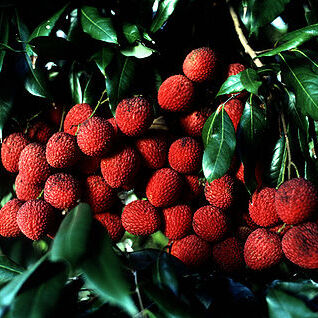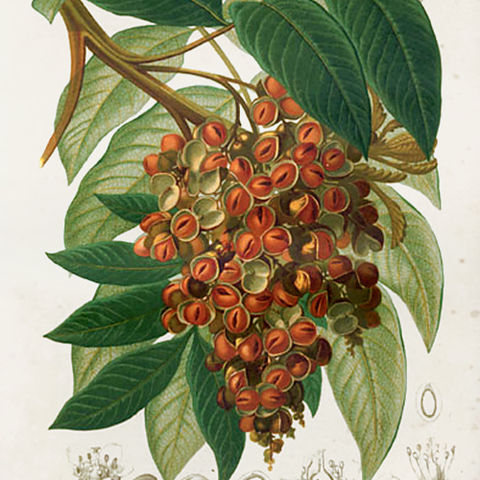Trees, shrubs or rarely herbs, sometimes climbing by tendrils. Indumentum commonly of simple hairs, sometimes in tufts in the axils of leaf-veins, rarely fasciculate; glands of several kinds occurring on both vegetative and flowering parts. Leaves alternate, sometimes crowded (palm-like) at the apex of the tree, variously simple, ternate, biternate, pinnate or bipinnate, in the latter two kinds most often without a terminal leaflet at maturity; stipules lacking or small. Inflorescences axillary or cauliflorous, thyrsoidal, paniculate or racemose. Flowers regular or slightly zygomorphic, unisexual except in some Dodonaea but with non-functional organs of the other sex usually present. Calyx of (3–)4–5(–7) free or partially united imbricate or valvate sepals. Petals absent or 4–5, often with a basal claw, usually with a simple or elaborated scale on the inner face. Disk conspicuous, simple, or rarely a double ring, or reduced to a pair of glands. Stamens 5–20(–74), often 8, but sometimes variable in number within a species, inserted in most cases inside the disk or occasionally on its surface; filaments free, terete or barely flattened, glabrous or hairy; anthers variously ovoid-sagittate to spherical, sometimes pilose, the connective rarely glandular, dehiscing introrsely by longitudinal slits; pollen grains tricolporate. Ovary 1–8-locular; ovules usually 1–2 (rarely several) per locule; style apical, except in >i>Allophylus where semi-gynobasic, entire or 2–3-lobed. Fruit a capsule, sometimes lobed, or drupe, often composed of one matured mericarp with the aborted remaining carpels visible at its base. Seed usually with a hard black or brown testa, which in one case contains stomata, often with a conspicuous fleshy aril or sarcotesta, without endosperm
Trees, shrubs or climbers, rarely herbaceous; dioecious, monoecious, andromonoecious, androdioecious or polygamodioecious, rarely polygamous; some with saponin in bark, leaves and pericarp. Leaves alternate or opposite (e.g. Acer), simple, trifoliolate, biternate or pinnate; petiole and petiolule usually pulvinate, usually exstipulate. Inflorescence axillary, terminal or ramiflorous, usually thyrsoid, raceme-like, panicle-like or cymose or flowers sometimes solitary or fasciculate. Flowers small, regular or irregular, unisexual or bisexual, usually pedicellate; bracteate. Sepals 4–10, usually united, sometimes free or basally connate, imbricate or valvate. Petals absent or (2–) 4–6, free, often clawed, with 1 or 2 hairy scales inside towards base; scales crested or not, sometimes absent. Disc usually present. Stamens (3–) 4–10 (–74), usually 8, inserted within disc, free, reduced in females, exserted in males; anthers 2-locular, longitudinally dehiscent. Ovary usually superior, 1–8-locular, rudimentary in males; ovules usually 1 or 2 per locule; style 1, entire or with 2-or 3-lobed stigma, rarely absent. Fruit drupaceous, capsular or separating into cocci, or a winged schizocarp (e.g. double samara in Acer), when capsular the dehiscence loculicidal or septicidal, rarely septifragal, sometimes irregular. Seeds usually with aril, non-endospermic.
Ovary of 2–8 carpels completely connate or only at the base, loculi 1–2-ovulate, ovules anatropous; style 1; pistillode usually present in female flowers
Leaves alternate (rarely opposite, not in our area), simple, 1-foliolate, 3-foliolate, biternate, decompound, paripinnate, imparipinnate or bipinnate
Ovary superior, entire or vertically lobed to the base, 1–8-celled; style terminal or gynobasic; ovules 1–2, rarely many in each cell, axile
Fruit capsular or fleshy and indehiscent (berry or drupe) or composed of 1 or more indehiscent cocci (often reduced to 1 by abortion)
Inflorescences usually racemoid or paniculate terminal or axillary or caulinary thyrses, or flowers sometimes fasciculate
Stamens usually 5–12 (occasionally more numerous), free or ± connate at the base, reduced or rarely absent in 9 flowers
Stamens hypogynous, often 8, inserted within the disk or unilateral; filaments free, often hairy; anthers 2-celled
Leaves alternate or rarely opposite, simple, or 1-or 3-foliolate, or pinnate or bipinnate; stipules rarely present
Seeds without endosperm, often conspicuously arillate; embryo with usually plicate or twisted cotyledons
Flowers actinomorphic or zygomorphic, sometimes very small, mostly unisexual, variously arranged
Disk usually extra-staminal, sometimes unilateral (absent in Dodonaea)
Flowers usually spuriously polygamo-dioecious, more rarely monoecious
Stipules absent (except in Paullinia and Cardiospermum in our area)
Petals 0–5, usually with 1–2 scales at the base of the lamina
Seeds without endosperm, often with an arillode
Trees, shrubs or climbers (rarely herbaceous)
Fruit capsular or indehiscent, rarely winged
Disk usually present, sometimes unilateral
Petals 1–5, sometimes absent, imbricate
Sepals usually 4–5, often ± connate
Sepals imbricate or rarely valvate
Trees, shrubs or climbers


